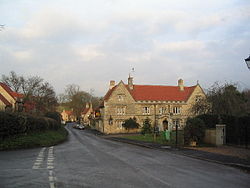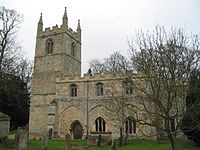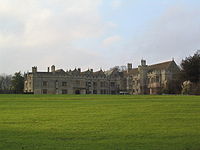Irnham
| Irnham | |
| Lincolnshire | |
|---|---|
 The Griffin Inn, Irnham | |
| Location | |
| Grid reference: | TF024267 |
| Location: | 52°49’44"N, 0°28’52"W |
| Data | |
| Population: | 206 |
| Post town: | Grantham |
| Postcode: | NG33 |
| Dialling code: | 01476 |
| Local Government | |
| Council: | South Kesteven |
| Parliamentary constituency: |
Grantham and Stamford |
Irnham is a village in Kesteven, the south-western part of Lincolnshire, about ten miles south-east of Kesteven's main town, Grantham. To the north is Ingoldsby and to the south-west, Corby Glen. The village is on a high limestone ridge that forms part of the Kesteven Uplands.
The civil parish of Irnham includes the hamlets of Bulby and Hawthorpe. The similar extent church Parish of Irnham, in the Diocese of Lincoln, is part of a group which includes Corby Glen and Swayfield, sharing a single priest. The parish church is dedicated to St Andrew.
The village public house is the Griffin Inn on Bulby Road. Most other employment is in farming.
Contents
St Andrew's Church
St Andrew's Church is late Norman with Perpendicular Gothic additions, and was heavily restored in 1858, and again in 2006. It holds the tomb and Easter Sepulchre of Geoffrey Luttrell, who commissioned the Luttrell Psalter, a celebrated mediæval manuscript now in the British Library, in the early 14th century.[1]
History
Irnham is listed as "Gerneham" in the Domesday Book. Its name has been postualated to derive from the Old English Geornan ham, which would mean 'Georna's Homestead' after an otherwise unknown progenitor.
Scenes of 14th-century life in the village are depicted in the Luttrell Psalter.[2][3]
Irnham Hall
Irnham Hall was the ancient seat of the Paynells and from about 1200, the Luttrell family, Lords of Irnham until 1418. The Manor then passed by marriage to the Hilton family and similarly in 1510 to the Thimbleby family, by whom the present Tudor house was built in about 1600.[4] In 1430, Godfrey Hilton, a knight, was residing in "Irenham".[5]
In 1853 William Hervey Woodhouse (d. 1859), who married Sarah Elizabeth Cole,[6] bought the Hall, which had several further owners until purchased in 1901 by the present owners, the Benton Jones family. A fire in 1887 destroyed much of the interior.[7]
Thimblesby's Almshouses
The village almshouses, built in 1712, are still in use.[8]
Outside links
| ("Wikimedia Commons" has material about Irnham) |
References
- ↑ National Monuments Record: No. 348411 – Church of Saint Andrew
- ↑ "British Library page about the Psalter". http://www.bl.uk/onlinegallery/sacredtexts/luttrellpsalter.html.
- ↑ Sancha, Sheila (1983). The Luttrell Village: Country Life in the Middle Ages. Ty Crowell. ISBN 978-0-690-04323-5. https://archive.org/details/luttrellvillagec00sanc. A children's interpretation
- ↑ National Monuments Record: No. 348432 – The Hall
- ↑ Plea Rolls of the Court of Common Pleas; National Archives; CP 40 / 677; 4th entry from the bottom, where he is being sued for debt by Ralph Barton, a London skinner
- ↑ Hatchment hung on tower arch, Irnham church
- ↑ Book of British Villages. Drive Publications Ltd. 1980. p. 235.
- ↑ National Monuments Record: No. 348422 – Thimblesby's Almshouses

